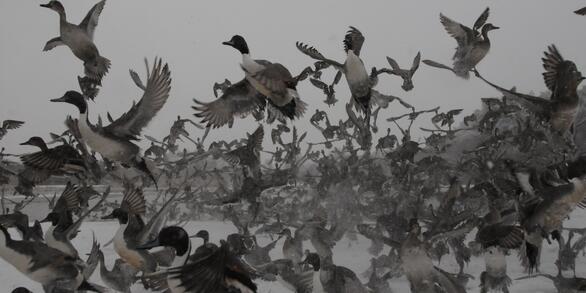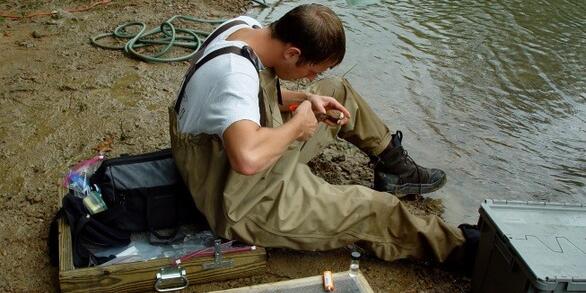Fish and Wildlife Disease Investigation and Surveillance
Fish and Wildlife Disease Investigation and Surveillance
At the Eastern Ecological Science Center (EESC), we strive to provide world-class science to inform natural resource decisions that preserve and enhance our quality of life.
Filter Total Items: 95
Immune System Changes and Susceptibility to Disease in Birds Exposed to Environmental Contaminants
Disease dynamics in wildlife are commonly related to changes or increases in environmental stressors that are placed upon an animal. Environmental pollutants are known to affect the immune system of wildlife, resulting in impaired resistance to infection and potential increases in disease outbreaks. In collaboration with: Jill Jenkins, Ph.D USGS Wetland and Aquatic Research Center; Julia Lankton...
Effects of Short Chain Chlorinated Paraffins (SCCPs) on developing birds
The Challenge: Short-Chain Chlorinated Paraffins (SCCPs) are complex technical mixtures of polychlorinated n-alkanes used in lubricants and coolants in metalworking, as flame retardants, and in paints, adhesives, sealants, textiles and polymeric materials, plastics and rubber. SCCPs are of concern because they are globally transported, bioaccumulate in wildlife and humans, and are environmentally...
Do pesticide coatings on agricultural seeds pose a threat to earthworms and to the birds that eat them?
Earthworms are a vital part of a healthy, functioning soil ecosystem and are also an important protein-rich food source for wildlife, including many species of birds and mammals. In an agricultural setting, the presence of earthworms can increase crop yields by 25%, but can also expose earthworms to pesticides. Seed treatment is the principal application method for neonicotinoid insecticides, one...
Terrestrial wildlife and legacy oil mining on National Wildlife Refuges
Amphibian surveys are being conducted on select National Wildlife Refuges with active and/or legacy oil mining to determine species relative distribution and their risk to short- and long-term effects from exposure to crude oil and its byproducts.
Produced water from Marcellus Shale and amphibians
Research biologists at the USGS Eastern Ecological Science Center (EESC) at the Patuxent Research Refuge are conducting a series of scientific studies on the potential effects of wastewater from hydraulic fracturing activities on terrestrial wildlife. Findings will help in assessing proposals for managing recycling and distribution of large volumes of flowback and produced waters generated by...
Dysbiosis, immunomodulation, and health effects of agricultural pesticides in wild prairie grouse
Agrochemical pollution poses a severe threat to biodiversity. Agrochemicals can detrimentally affect wildlife growth, development, survival, reproduction, and immune responses, which facilitates emergence and spread of infectious diseases that may cause unusually high mortality. Animal microbiota plays a fundamental role in host’s food detoxification and defense against pathogens, regulates...
Restoring a native fish to Catoctin Mountain Park
Native species conservation is a fundamental purpose of National Parks. Catoctin Mountain Park (CATO) in Maryland supports a prized trout fishery and a healthy community of native fishes, with one exception: native Blue Ridge Sculpin ( Cottus caeruleomentum) appear to have been extirpated from Big Hunting Creek above Cunningham Falls. Infection by a fungal-like protist Dermocystidium is...
Assessing stream health and fish habitat in streams of the Chesapeake Bay Watershed
Streams and rivers provide habitat for a diverse array of aquatic and semi-aquatic species. However, human alteration to landscapes and riverscapes has affected this habitat resulting in its degradation and thus loss of habitat and associated sensitive aquatic species. While this relationship has been known for many years, only recently has the availability of data and analytical capabilities...
Whole Wildlife Toxicology Catalog
Developed in 2008, the Whole Wildlife Toxicology Catalog is a portal to wildlife toxicology-oriented websites and databases. The catalog attempts to compile and provide access to website containing information that should be of value to scientists, regulators, natural resource managers, students and other members of the public. The catalog is updated annually. Please contact Barnett Rattner if you...
Novel approach using flocculation to concentrate edna to search for early invasions of specific aquatic invasive species
Early detection systems for aquatic nuisance species have been improved by the advancement of polymerase chain reactions that amplify DNA sequences for decoding.
Use of next-generation sequencing for the dietary analyses of smallmouth bass (Micropterus dolomieu) stomach content
The USGS Eastern Ecological Science Center scientists are collaborating with the PADEP (SMB) to develop and evaluate a genetic assay for fish diets that will allow us to develop a cost-effective monitoring program for determining the diet of wild fish.
Assessing the effects of chloride exposure on aquatic organisms
Increased salinization of freshwater systems is a growing concern, and can be attributed to a variety of factors including climate change, land-use change, agricultural practices, road de-icing, and brines released from fossil fuel extraction. Effects of increased salinization on aquatic organisms is little understood and may be vastly different among species and among different life stages.
















